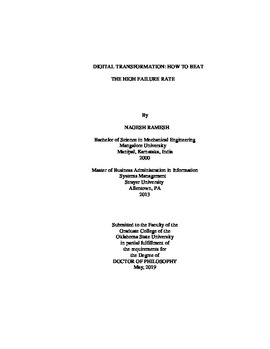| dc.contributor.advisor | Delen, Dursun | |
| dc.contributor.author | Ramesh, Nagesh | |
| dc.date.accessioned | 2019-10-25T19:51:43Z | |
| dc.date.available | 2019-10-25T19:51:43Z | |
| dc.date.issued | 2019-05-01 | |
| dc.identifier.uri | https://hdl.handle.net/11244/321571 | |
| dc.description.abstract | Firms every year spend $1.3 trillion on digital transformation programs to improve efficiency because digital leaders outperform their peers in nearly every industry. However, digital transformations that are intended to improve efficiency (e.g., ERP, CRM, Analytics, etc.) have a high failure rate (up to 90%), resulting in adverse impact to firms' operations and intent to further innovate. While extant research talks about the importance of vision, management, and culture as critical success factors, even digital transformations within the same firm often fail to achieve similar results. Based on Diffusion of Innovation theory and data from three digital transformation programs within a firm that achieved vastly different results, I posit five factors as key influencers of digital transformation success: a) Innovation Attributes, b) Opinion Leaders, c) Diffusion Approach, d) Timing, and e) Duration. I also use machine learning (ML) techniques such as leave-one-out-cross-validation (LOOCV) to show the superiority of ML over regression to determine feature importance. In addition to contributing to theory, this research will help practitioners increase the success rate of future digital transformations. | |
| dc.description.abstract | In the first chapter, I introduce the reader to digital transformation, why firms want to digitally transform, and the high failure rate these firms face when they embark on digital transformation. In the second chapter, I perform a literature review of key digital transformation research performed to date and define the underlying theory and the factors used in this study. In the third chapter, I describe the research design and its appropriateness for studying the research question. In the fourth chapter, I perform hypothesis testing with sample data from three studies to test whether the five factors significantly influence digital transformation outcome. In the sixth chapter, I use the machine learning technique LOOCV to determine feature importance. Finally, in the last chapter I describe the key research contributions of this research and future directions. | |
| dc.format | application/pdf | |
| dc.language | en_US | |
| dc.rights | Copyright is held by the author who has granted the Oklahoma State University Library the non-exclusive right to share this material in its institutional repository. Contact Digital Library Services at lib-dls@okstate.edu or 405-744-9161 for the permission policy on the use, reproduction or distribution of this material. | |
| dc.title | Digital Transformation: How to Beat the High Failure Rate | |
| dc.contributor.committeeMember | Joplin, Toby | |
| dc.contributor.committeeMember | Rao, Ramesh | |
| dc.contributor.committeeMember | White, Margaret | |
| osu.filename | Ramesh_okstate_0664D_16095.pdf | |
| osu.accesstype | Open Access | |
| dc.type.genre | Dissertation | |
| dc.type.material | Text | |
| dc.subject.keywords | diffusion approach | |
| dc.subject.keywords | digital transformation | |
| dc.subject.keywords | innovation | |
| dc.subject.keywords | machine learning | |
| dc.subject.keywords | opinion leaders | |
| dc.subject.keywords | timing | |
| thesis.degree.discipline | Business Administration | |
| thesis.degree.grantor | Oklahoma State University | |
